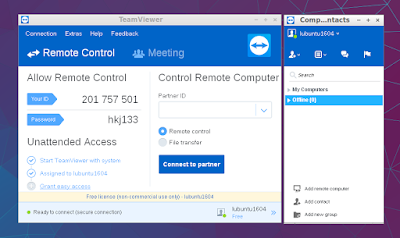
With this the resolution changes to fit the size of the client window no matter what it is, and it's not zooming, it's actual resolution change (I can see the new resolution in xrandr output).
VNC VIEWER LUBUNTU WINDOWS
Windows some version with Tiger VNC Client.but it resizes when I change the TigerVNC Client window. I don't know what the TigerVNC client tells remote vncserver or xrandr or Xvnc or gnome or. Perhaps the most ignorant answer I've posted but here goes: Use TigerVNC client/viewer and check 'Resize remote session to local window' under Screen tab of options. Line: VNC-0 connected 1600x900+0+0 0mm x 0mmīind the new modeline to the current VNC virtual monitor: $ xrandr -addmode VNC-0 "2560x1600_60.00"

In the above xrandr output look for the display name on the second Or if the monitor is old get the GTF timings: $ gtf 2560 1600 60 List the modeline (see xrandr article in ArchLinux wiki) for

Screen 0: minimum 32 x 32, current 1600 x 900, maximum 32768 x 32768Īnd you'll notice the screen being quite small. Once inside the VNC session start up a terminal window.Ĭonfirm that the new geometry is available in the VNC session: $ xrandr On the "2560x1600" computer start the VNC viewer (I prefer Start a VNC session with a geometry matching the physical display: $ vncserver -geometry 1600x900 :1 The computer with the resolution of "1600x900": With that background if the goal is to share a VNC session between twoĬomputers with the above resolutions and assuming that the VNC server is There must be a way to add custom modelines and man xrandr confirms

VNC VIEWER LUBUNTU CODE
Think the developers who wrote the code are much smarter and the hardĬoded list is just a sample of values. Xrandr allows selecting the display modes (a.k.a resolutions) howeverĪny additional modeline such as "2560x1600" or "1600x900" would need to I'm using TightVnc viewer as the client and it automatically adapts to the new resolution.Īs this question comes up first on Google I thought I'd share a solution using TigerVNC which is the default these days. I can then easily switch to another resolution (f.e. When I run xrandr in a terminal, it displays all the available screen resolutions: bash> xrandr I just start vncserver without any -randr or multiple -geometry options. I'm running TigerVNC on my Linux server, which has basic randr support.


 0 kommentar(er)
0 kommentar(er)
